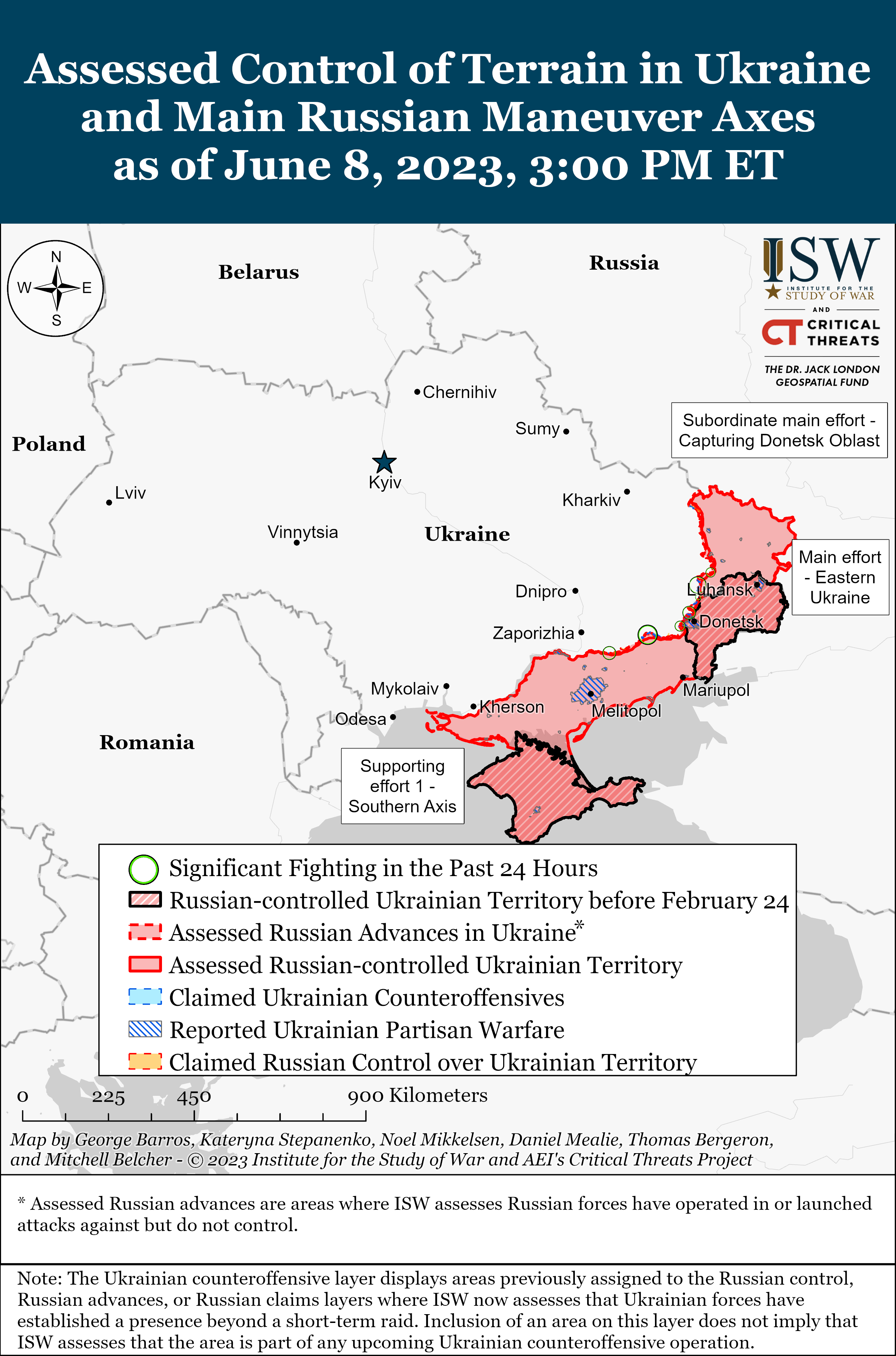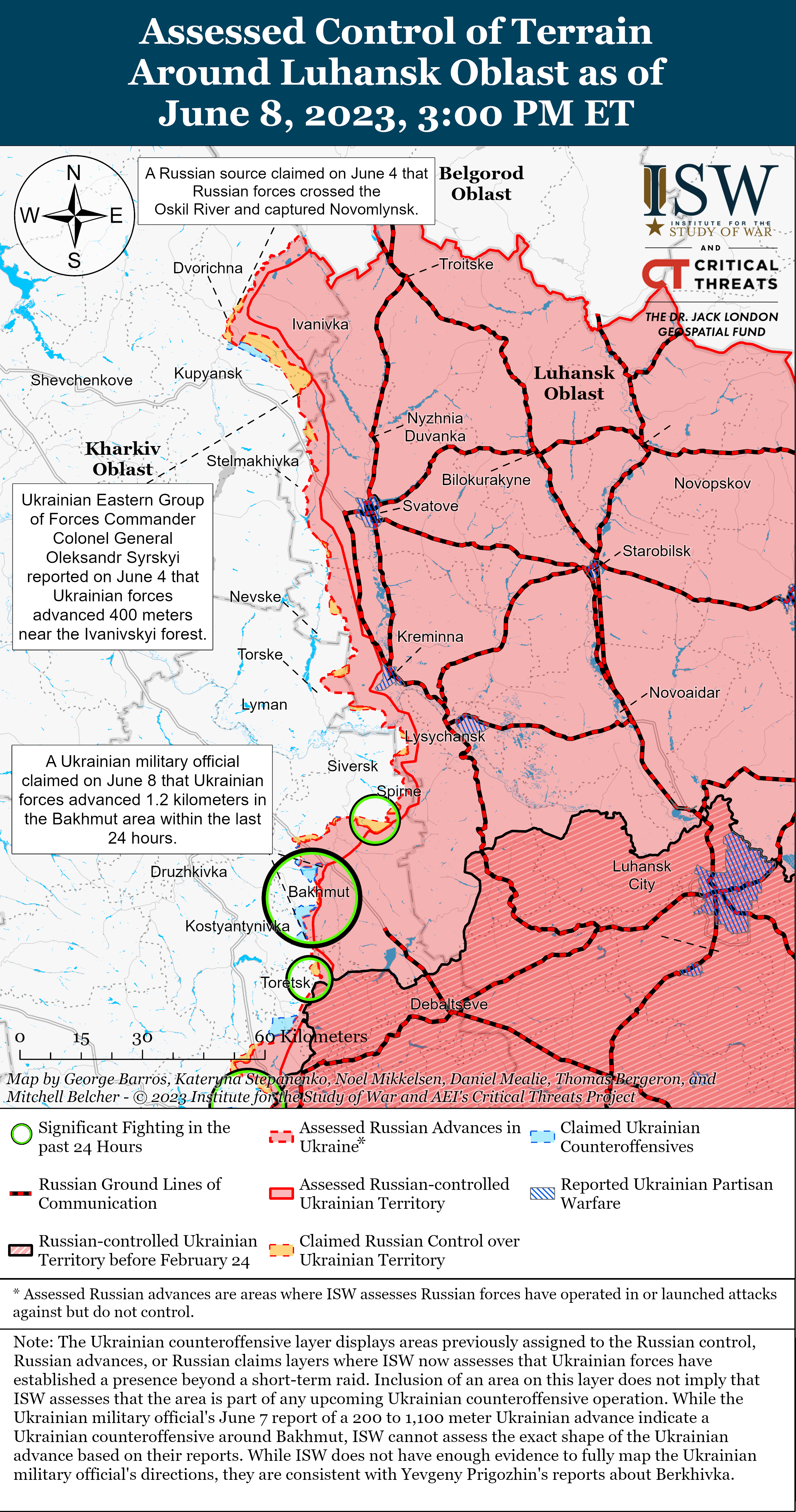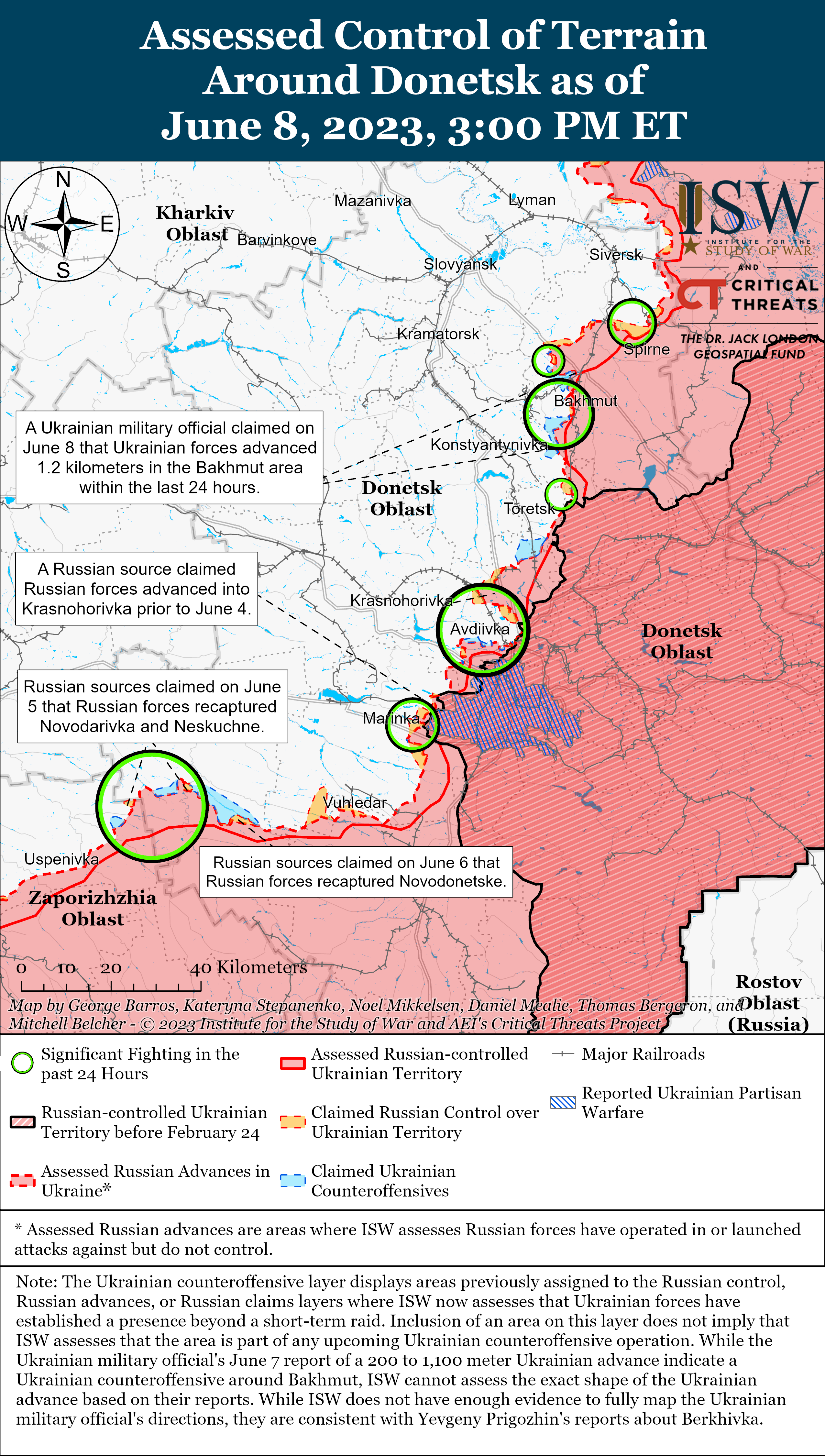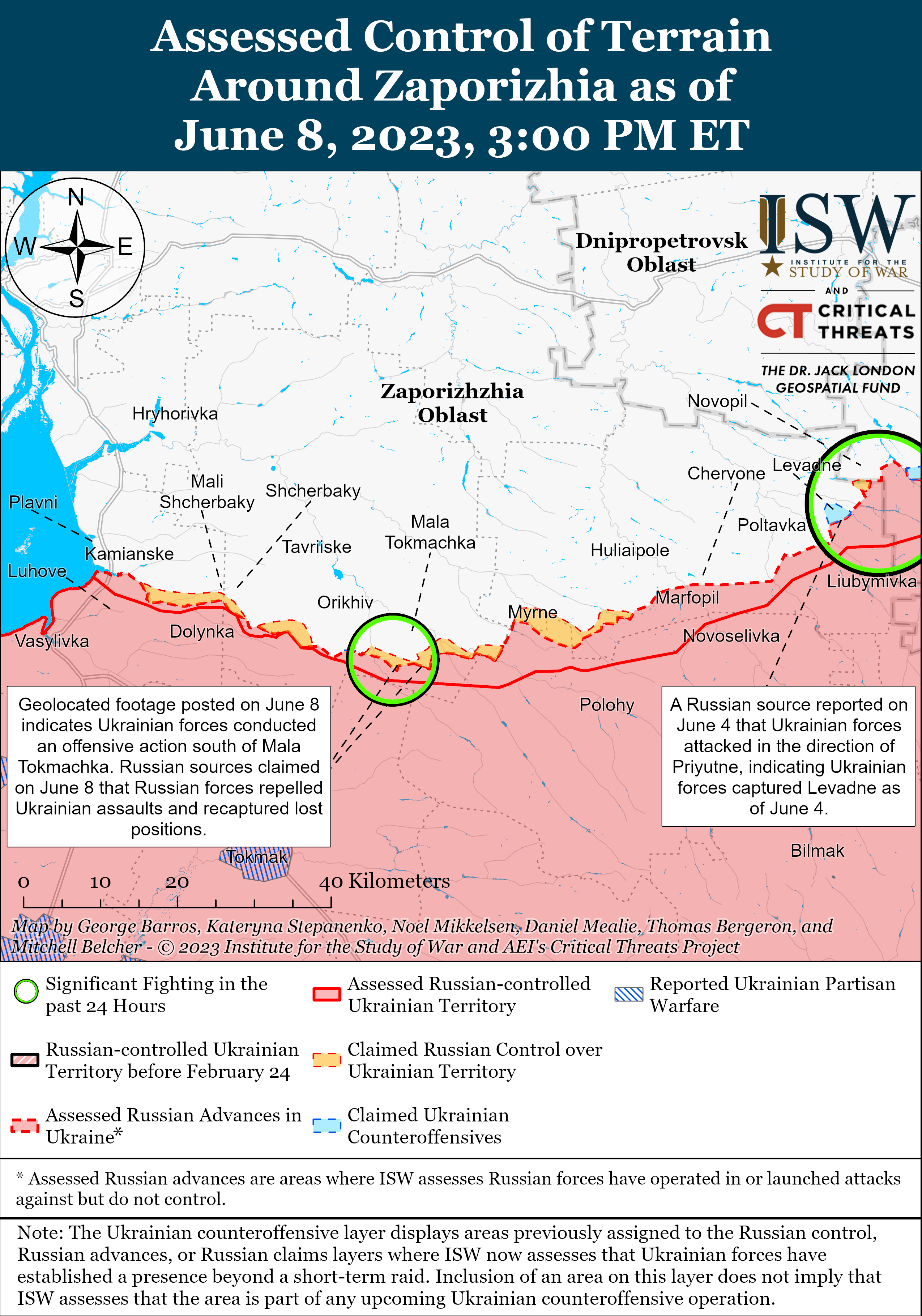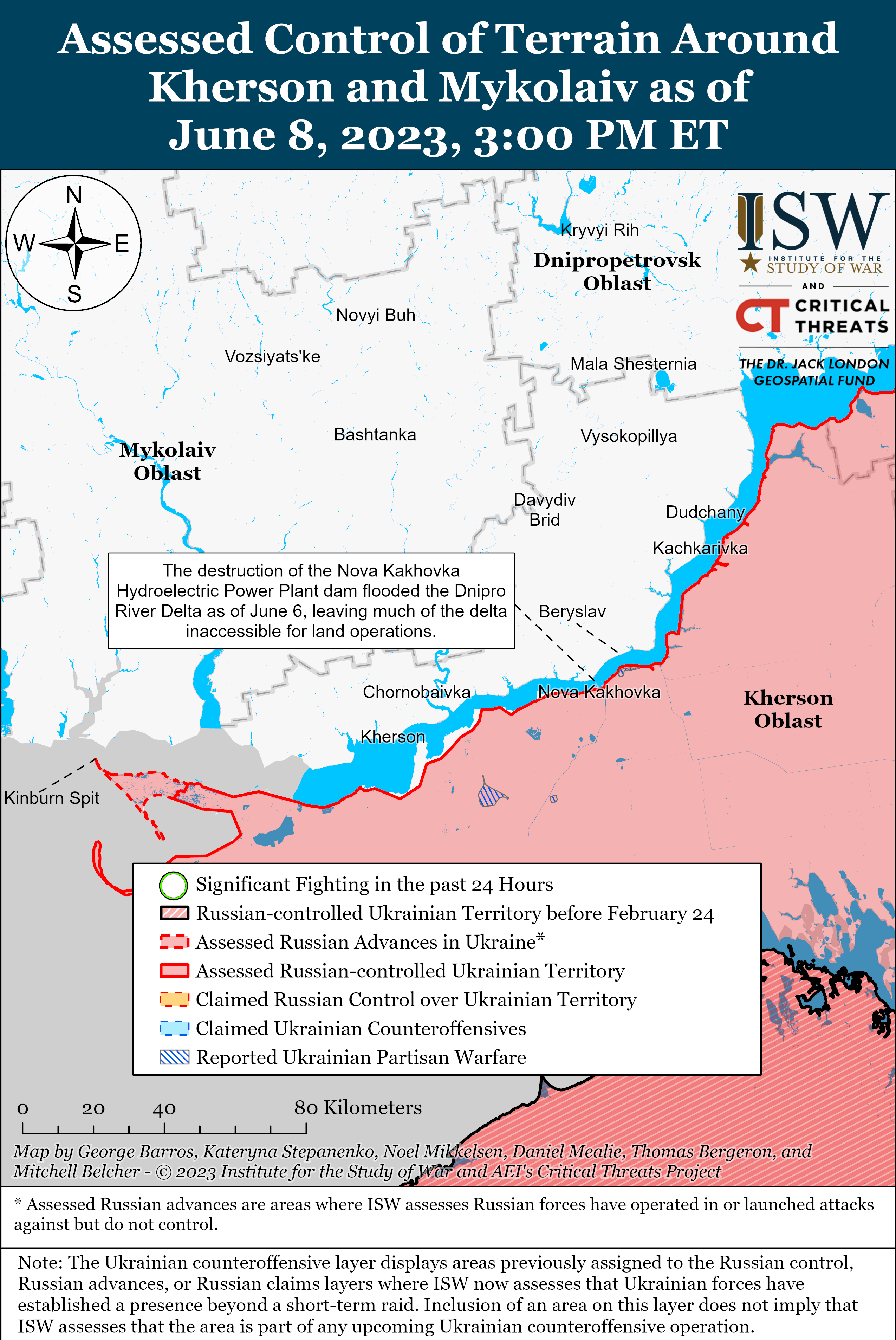Karolina Hird, George Barros, Grace Mappes, Nicole Wolkov,
Mason Clark, and Fredrick W. Kagan
June 8, 2023, 7:30pm ET
Click here to see ISW’s interactive map of the Russian invasion of Ukraine. This map is updated daily alongside the static maps present in this report.
Click here to access ISW’s archive of interactive time-lapse maps of the Russian invasion of Ukraine. These maps complement the static control-of-terrain map that ISW produces daily by showing a dynamic frontline. ISW will update this time-lapse map archive monthly.
Note: The data cutoff for this product was 2pm ET on June 8. ISW will cover subsequent reports in the June 9 Russian Offensive Campaign Assessment.
Ukraine has conducted counteroffensive operations with differential outcomes in at least three sectors of the front as part of wider counteroffensive efforts that have been unfolding since Sunday, June 4. Ukrainian officials signaled that Ukrainian forces have transitioned from defensive to offensive operations in the Bakhmut sector and are making gains of between 200 meters and nearly two kilometers on the flanks of the city.[1] Ukrainian forces have made tactical gains during limited localized counterattacks in western Donetsk Oblast near the Donetsk-Zaporizhia Oblast border since June 4.[2] Ukrainian forces additionally conducted an attack in western Zaporizhia Oblast on the night of June 7 to 8 but do not have appeared to have made gains as part of this attack as of the time of this publication.
Ukrainian forces conducted a limited but still significant attack in western Zaporizhia Oblast on the night of June 7 to 8. Russian forces apparently defended against this attack in a doctrinally sound manner and had reportedly regained their initial positions as of June 8. Russian sources began reporting late at night on June 7 that elements of Ukrainian brigades that have recently been equipped with Western kit launched an attack southwest of Orikhiv in western Zaporizhia Oblast.[3] Several Russian milbloggers claimed that Ukrainian forces attacked along the Mala Tokmachka-Polohy line with the aim of breaking through the Russian defensive line between Robotyne and Verbove (both about 15km southeast of Orikhiv).[4] Russian sources acknowledged that Ukrainian forces broke through the first line of defense in this area, held by elements of the 291st and 70th Motorized Rifle Regiments (42nd Motorized Rifle Division, 58th Combined Arms Army, Southern Military District) and the 22nd and 45th Separate Guards Special Purpose (GRU) Brigades, but reported that these Russian elements succeeded in counterattacking and eventually pushing Ukrainian forces back to their original positions.[5] Available geolocated combat footage suggests that limited Ukrainian forces crossed the N08 Polohy-Voskresenka highway, but Russian sourcing indicates that Russian forces likely pushed Ukrainians back in the Orikhiv direction towards the frontline and regained the lost positions.[6]
Ukrainian forces also reportedly lost Western-provided vehicles on June 8.[7] Losses are inevitable during any military undertaking. Ukrainian forces will suffer losses, including of both Western and Soviet equipment, during any offensive operations. Western equipment is not impervious to damage any more than the equipment that the Ukrainians have been using and losing since February 2022. The loss of equipment — including Western equipment — early on in the counteroffensive is not an indicator of the future progress of Ukraine’s counteroffensive. It is important not to exaggerate the impact of initial losses of Western or any other equipment, particularly in penetration battles against prepared defensive positions.
The Russian Ministry of Defense (MoD) responded to the Ukrainian attack with an uncharacteristic degree of coherency and praised Southern Military District elements for repelling the attack and regaining lost positions. The Russian MoD published a video statement by the commander of the Russian grouping in the Zaporizhia direction, Colonel General Alexander Romanchuk, wherein Romanchuk reported that Ukrainian forces started attacking around 0200 local time June 8 and that Russian forces, particularly those of the 42nd Motorized Rifle Division, succeeded in repelling the attack.[8] Romanchuk claimed that Ukrainian forces telegraphed the ground attack with extensive artillery preparation of the battlefield.[9] The Russian MoD also released a statement by 58th Combined Arms Army Commander Major General Ivan Popov, who credited elements of the 58th Combined Arms Army with effectively laying mines to impede Ukrainian advances.[10] The overall Russian response to the attack, both among various milbloggers and the Russian MoD, was notably coherent and relatively consistent with the available visual evidence, which may suggest that Russian forces were not surprised and reacted in a controlled and militarily sound manner. As ISW has previously assessed, the Russian information space reacts with a high degree of chaos and incoherence when taken by surprise by battlefield developments that do not allow the propaganda apparatus to develop a clear line.[11] By contrast, the Russian responses to this attack suggest that Russian forces defended in the way that they had prepared to, thus giving Russian sources a rhetorical line to coalesce around.
Russian sources provided explanations for claimed Russian successes during the June 8 attacks, praising Russian forces’ effective use of electronic warfare (EW) systems, air support, and landmines against Ukrainian forces. Multiple Russian sources reported that Russian EW severely interfered with Ukrainian command and control signals, GPS-enabled devices, UAV controls.[12] Russian sources reported that Ukrainian forces had insufficient air defense in the Orikhiv sector, that Russian forces operated with an “unprecedented” amount of rotary wing air support, and that Russian aviation was able to return to a high level of activity after not actively engaging in combat operations since the beginning of the full-scale invasion in 2022.[13] Continuous Russian missile and drone attacks against Kyiv and critical Ukrainian infrastructure may have fixed Ukraine’s more advanced air defense systems away from the frontline, although ISW cannot assess which systems would be effective against the kinds of air support missions Russian aircraft were flying. ISW’s previous assessments that Russian air and missile attacks were not setting conditions to defend against the Ukrainian counter-offensive may thus have been inaccurate. Russian sources also praised at length their claimed defensive success using layered field fortifications and landmines, with Major General Popov stating that Russian minefields played a “very important role” in defeating the initial Ukrainian advance in the early hours of June 8.[14] CNN additionally reported that an anonymous US official said that Russian landmines degraded Ukrainian armored vehicles.[15]
Russian forces appear to have executed their formal tactical defensive doctrine in response to the Ukrainian attacks southwest of Orikhiv. Russian doctrine for a defending motorized rifle battalion calls for a first echelon of troops to repel or slow attacking forces with minefields, fortifications, and strongpoints, with a second echelon of forces counterattacking against an enemy breakthrough.[16] Russian forces apparently operated in this fashion in this sector – Ukrainian forces penetrated the initial defensive lines; Russian forces pulled back to a second line of fortifications; and Russian reserves subsequently counterattacked to retake the initial line of defenses.[17] This maneuver is a regular feature of defensive operations and has been executed by both Ukrainian and Russian forces throughout the war. Early control of terrain changes day to day should thus not be misconstrued as the overall result of a wider attack.
Ukrainian attacks in western Zaporizhia on June 8 do not represent the full extent of Ukrainian capabilities in the current counteroffensive. Ukraine previously demonstrated the ability to conduct a coordinated and effective offensive operation using multiple mechanized brigades as early as September 2022 during the liberation of Kharkiv Oblast. Ukrainian forces possessed this capability – in terms of both available forces and the capacity to coordinate complex attacks – before the provision of Western kit for offensive brigades and additional training from NATO partners. Ukraine’s counteroffensive will likely consist of many undertakings of varied size, including more localized attacks as observed in this sector on June 8, and the smaller efforts do not represent the maximum capacity of Ukrainian numbers or effectiveness. Ukraine reportedly formed 12 dedicated counteroffensive brigades, nine equipped with Western kit and three with existing equipment, and these units will almost certainly be joined by experienced Ukrainian units already online.[18] Ukraine appears to have committed only a portion of the large reserve of forces available for counteroffensive operations, and observers should avoid counting down reported Ukrainian brigades committed or reportedly damaged Western kit as the measure of the remaining effective combat power of Ukrainian forces.
It is additionally noteworthy that the Russian Southern Military District Forces deployed in this particular area are likely to be a higher quality force grouping than Russia has elsewhere in theater, and their defensive performance is unlikely to be reflective of defensive capabilities of Russian groupings elsewhere on the front. Elements of the 58th Combined Arms Army have been deployed in a doctrinally consistent manner to the Orikhiv area and have been conducting defensive preparations in this sector of the front for several months.[19] The 291st and 70th Motorized Rifle Regiments in particular have reportedly gained experience in defending against limited Ukrainian reconnaissance-in-force efforts this area over the past months and have had time to commit to and prepare for defensive operations and familiarize themselves with the terrain.[20] The 58th Combined Arms Army elements in this sector, therefore, are likely generally fresher and more experienced than elements in other areas of the front. The Russian defense of this sector should not be taken as indicative of overall Russian defensive capabilities as Ukraine continues counteroffensive operations. Russian forces defending in other sectors have indeed performed much more poorly. Ukraine, having recently regained the battlefield initiative across the theater, will be able to choose exactly where in to continue attacking based on observed defensive capabilities of various Russian groupings along the frontline among other factors.
Russian forces and occupation authorities continue to exacerbate the humanitarian ramifications of the flooding resulting from the Kakhovka Hydroelectric Power Plant (KHPP) dam break. The Ukrainian General Staff reported on June 8 that Russian forces are hiding amongst civilians who are evacuating from flooded settlements on the east (left) bank of the Dnipro River and that occupation authorities are housing evacuated residents in boarding houses and recreation centers where Russian troops and equipment are located.[21] Several Ukrainian and Western sources additionally reported that Russian troops shelled a flooded evacuation site in Kherson City, killing one civilian and injuring nine.[22] Russian occupation authorities claimed that Ukrainian forces shelled evacuation efforts on the east bank but did not provide visual evidence commensurate with these allegations.[23]
Russian President Vladimir Putin has reportedly postponed his annual press conference from June 2023 until November or December 2023.[24] Russian news outlet Kommersant claimed on June 8, citing sources within the Kremlin, that Putin is postponing his annual “Direct Line” live journalistic forum until the Russian military situation is more stable, which the sources characterized as likely in November or December. Kommersant’s source reportedly stated that these dates are preliminary, and that Putin aims to hold the “Direct Line” before the March 2024 presidential elections.[25] ISW has previously assessed that Putin would likely hold the “Direct Line” in early June 2023 after Russian forces captured Bakhmut, and pushing back the forum indicates that the Kremlin may perceive the capture Bakhmut as an insufficient informational victory to compensate for the overall unstable Russian military situation in Ukraine.[26] Delaying the “Direct Line” forum further illustrates Putin’s decline from a seemingly involved and strong leader to one more often portrayed as minutely involved in small infrastructure projects, as ISW has previously noted.[27]
Key Takeaways
- Ukraine has conducted counteroffensive operations with differential outcomes in at least three sectors of the front as part of wider counteroffensive efforts that have been unfolding since Sunday, June 4.
- Ukrainian forces conducted a limited but still significant attack in western Zaporizhia Oblast on the night of June 7 to 8. Russian forces apparently defended against this attack in a doctrinally sound manner and had reportedly regained their initial positions as of June 8.
- The Russian Ministry of Defense (MoD) responded to the Ukrainian attack with an uncharacteristic degree of coherency and praised Southern Military District elements for repelling the attack and regaining lost positions.
- Russian sources provided explanations for claimed Russian successes during the June 8 attacks, praising Russian forces’ effective use of electronic warfare (EW) systems, air support, and landmines against Ukrainian forces.
- Russian forces appear to have executed their formal tactical defensive doctrine in response to the Ukrainian attacks southwest of Orikhiv.
- Ukrainian attacks in western Zaporizhia on June 8 do not represent the full extent of Ukrainian capabilities in the current counteroffensive.
- It is additionally noteworthy that the Russian Southern Military District Forces deployed in this particular area are likely to be a higher quality force grouping than Russia has elsewhere in theater, and their defensive performance is unlikely to be reflective of defensive capabilities of Russian groupings elsewhere on the front.
- Russian forces and occupation authorities continue to exacerbate the humanitarian ramifications of the flooding resulting from the Kakhovka Hydroelectric Power Plant (KHPP) dam break.
- Russian President Vladimir Putin has reportedly postponed his annual press conference from June 2023 until November or December 2023.
- Russian forces continued to conduct limited ground attacks on the Kupyansk-Svatove line and around Kreminna.
- Ukrainian forces made limited gains around Bakhmut, and Russian forces conducted limited ground attacks along the Avdiivka-Donetsk City line.
- Ukrainian forces continued to conduct limited ground attacks on the administrative border between Donetsk and Zaporizhia oblasts.
- The Russian MoD continues to posture itself as a firm authority over the defense industrial base (DIB) through emphasizing its ability to transport new equipment to the front.
- Russian occupation authorities are reportedly resorting to punitive measures against civilian populations in occupied Ukraine due to Russian occupation authorities’ decreasing influence over civilians.
We do not report in detail on Russian war crimes because these activities are well-covered in Western media and do not directly affect the military operations we are assessing and forecasting. We will continue to evaluate and report on the effects of these criminal activities on the Ukrainian military and the Ukrainian population and specifically on combat in Ukrainian urban areas. We utterly condemn these Russian violations of the laws of armed conflict, Geneva Conventions, and humanity even though we do not describe them in these reports.
- Russian Main Effort – Eastern Ukraine (comprised of two subordinate main efforts)
- Russian Subordinate Main Effort #1 – Capture the remainder of Luhansk Oblast and push westward into eastern Kharkiv Oblast and encircle northern Donetsk Oblast
- Russian Subordinate Main Effort #2 – Capture the entirety of Donetsk Oblast
- Russian Supporting Effort – Southern Axis
- Russian Mobilization and Force Generation Efforts
- Activities in Russian-occupied areas
Russian Main Effort – Eastern Ukraine
Russian Subordinate Main Effort #1 – Luhansk Oblast (Russian objective: Capture the remainder of Luhansk Oblast and push westward into eastern Kharkiv Oblast and northern Donetsk Oblast)
Russian forces continued to conduct limited ground attacks on the Kupyansk-Svatove line and around Kreminna on June 8. The Ukrainian General Staff reported that Russian forces conducted unsuccessful offensive operations near Vesele (32km south of Kreminna).[28] A Russian milblogger claimed that Russian forces conducted ground attacks near Bilohorivka (10km south of Kreminna) and Berestove (30km south of Kreminna).[29] A Russian source claimed that positional battles continued near Masyutivka (12km northeast of Kupyansk) and that Russian forces destroyed three Ukrainian sabotage and reconnaissance groups near Novoselivske (13km northeast of Svatove) on June 7.[30] Ukrainian Deputy Defense Minister Hanna Malyar stated that Russian forces in the Kupyansk direction are conducting air and artillery strikes.[31]
Ukrainian forces continue to strike rear areas in occupied Luhansk Oblast. Luhansk People’s Republic (LNR) Head Leonid Pasechnik claimed on June 8 that Ukrainian forces struck Luhansk City, and geolocated footage shows a large smoke plume rising from the city.[32]
Russian Subordinate Main Effort #2 – Donetsk Oblast (Russian Objective: Capture the entirety of Donetsk Oblast, the claimed territory of Russia’s proxies in Donbas)
Click here to read ISW’s retrospective analysis on the Battle for Bakhmut.
Ukrainian forces made limited gains around Bakhmut on June 8. Geolocated footage published on June 7 indicates that Ukrainian forces made limited advances near Berkhivka (6km northwest of Bakhmut).[33] Ukrainian and Russian sources claimed that Ukrainian forces made advances 1.8km wide and 1.2km deep along the western bank of the Siverskyi Donetsk Canal west of Andriivka (10km southwest of Bakhmut) and forced elements of the Russian 57th Motorized Infantry Brigade (5th Combined Arms Army, Eastern Military District) and convict servicemen of the “Storm-Z” unit out of their positions.[34] The Ukrainian General Staff reported that Russian forces conducted unsuccessful offensive operations near Orikhovo-Vasylivka (11km northwest of Bakhmut), Ivanivske (6km west of Bakhmut), and Pivnichne (20km southwest of Bakhmut).[35] Ukrainian Ground Forces Commander Colonel General Oleksandr Syrskyi reported that Ukrainian forces are advancing in the Bakhmut direction.[36] Ukrainian Eastern Group of Forces Spokesperson Colonel Serhiy Cherevaty also stated at least 81,000 Wagner servicemen have been killed or wounded in the fighting around Bakhmut since July 2022.[37]
Russian forces conducted limited ground attacks along the Avdiivka-Donetsk City line on June 8. The Ukrainian General Staff reported that Russian forces conducted unsuccessful offensive operations near Avdiivka, Opytne (3km southwest of Avdiivka), Sieverne (6km west of Avdiivka), and Pervomaiske (11km southwest of Avdiivka) and that Ukrainian forces repelled Russian attacks on Marinka.[38] A Russian milblogger claimed that Ukrainian forces advanced near Vodyane (7km southwest of Avdiivka).[39] Chechen Republic Head Ramzan Kadyrov posted footage on June 8 showing Akhmat Special Forces (Spetsnaz) Commander Major General Apty Alaudinov claiming that Akhmat Spetsnaz units and elements of the 150th Motorized Rifle Division (8th Combined Arms Army, Southern Military District) are repelling Ukrainian attacks in Marinka.[40] Geolocated footage published on June 8 shows artillery elements of the 39th Separate Motorized Rifle Brigade (68th Army Corps, Eastern Military District) operating near Marinka.[41]
Russian Supporting Effort – Southern Axis (Russian objective: Maintain frontline positions and secure rear areas against Ukrainian strikes)
Ukrainian forces continued to conduct limited ground attacks on the administrative border between Donetsk and Zaporizhia oblasts on June 8. Ukrainian Deputy Defense Minister Hanna Malyar stated that fighting in the Velyka Novosilka direction continues.[42] Ukrainian Brigadier General Oleksandr Tarnavskyi stated that Ukrainian offensive operations in southern Ukraine are successful and that Russian forces are on the defensive.[43] The Russian Eastern Group of Forces (Eastern Military District) Spokesperson Oleg Chekhov claimed that Russian forces conducted air and artillery strikes against attacking Ukrainian forces in western Donetsk Oblast and against rear positions near Vremivka (immediately west of Velyka Novosilka) and Novodonetske (11km southeast of Velyka Novosilka).[44] Geolocated footage shows that Ukrainian forces struck Russian howitzer positions east of Staromlynivka (14km south of Velyka Novosilka) and destroyed a TOS-1A thermobaric artillery system just north of Zavitne Bazhannia (12km south of Velyka Novosilka).[45]
Ukrainian forces continue to strike rear areas of occupied southern Zaporizhia Oblast. Russian and Ukrainian officials reported that Ukrainian forces struck Tokmak on June 7 and 8.[46] Russian and Ukrainian sources also reported explosions in Berdyansk on June 8, and geolocated footage shows a large smoke plume rising in the city.[47]
Flooding from the destruction of the Kakhovka Hydroelectric Power Plant (KHPP) dam has reportedly forced Russian forces to withdraw further to rear areas in eastern Kherson Oblast and inflicted some manpower and equipment losses. Ukrainian Southern Operational Command Spokesperson Nataliya Humenyuk reported that Russian forces withdrew between five and 15 kilometers from the front line on the Dnipro River due to flooding of their frontline positions.[48] Russian forces likely no longer occupy Oleshky as of June 8 due to extensive flooding there.[49] The Ukrainian General Staff reported that Russian forces suffered manpower and equipment losses from the flooding, especially within the 7th Airborne (VDV) Division (Southern Military District) and 22nd Army Corps (Black Sea Fleet, Southern Military District).[50] The southern branch of the Ukrainian governmental organization “Forests of Ukraine” reported that flooding completely cut off the Kinburn Spit from mainland Ukraine as of the evening of June 7.[51] Russian forces previously established fortified positions on the Kinburn Spit, and it is unclear whether or not any Russian forces remain on the spit following the flooding. The Ukrainian Kherson Oblast Administration reported that the average level of flooding in Kherson Oblast is 5.61 meters, and that 32 percent of the flooding is concentrated in the west (right) bank, where20 settlements flooded, while 68 percent is concentrated in the east (left) bank.[52]
Decreasing water levels in the Kakhovka Reservoir do not currently threaten the Zaporizhzhia Nuclear Power Plant (ZNPP)’s cooling operations as of June 8.[53] International Atomic Energy Agency (IAEA) Director General Rafael Grossi stated on June 8 that the ZNPP is still drawing water from the Kakhovka Reservoir to cool its nuclear reactors even though the water level has dipped to levels below which experts previously estimated that the ZNPP’s water pumps could no longer operate. Grossi stated that the Kakhovka Reservoir water level has dropped from 16.8 meters to 12.7 meters and that the ZNPP can likely sustain cooling operations if the water level drops to 11 meters. Grossi stated that the water level is currently decreasing at a rate of four to seven centimeters per hour. Ukrainian nuclear energy operator Energoatom also stated that the water level in the ZNPP’s cooling pond is stable as of June 8.[54]
Russian Mobilization and Force Generation Efforts (Russian objective: Expand combat power without conducting general mobilization)
The Russian MoD continues to posture itself as a firm authority over the defense industrial base (DIB) through emphasizing its ability to transport new equipment to the front. The Russian MoD published footage on June 8 showing Russian Defense Minister Sergei Shoigu visiting troops in the Western Military District and inspecting weapons and equipment bound for Ukraine.[55] Shoigu emphasized the importance of installing additional protection on armored vehicles before transport to Ukraine and of decreasing the time between Russian forces receiving new equipment and sending it to combat areas.
The Kremlin is continuing crypto-mobilization efforts through introducing incentives and coercive measures aimed at promoting military service. Russian opposition outlet SOTA reported that the Russian Ministry of Internal Affairs (MVD) drafted a bill that would deprive individuals of their driver's license if they fail to appear at a military registration and enlistment office after 20 days of receiving the summons.[56] Russian opposition outlet Mobilization News reported that Russian authorities are advertising Russian MoD contracts to work in signals and medical fields to women under 47 years old.[57] The Russian MoD is reportedly offering these recruits a 125,000-to-350,000-ruble (about $1,500 to $4,250) monthly salary, and an unspecified organization is offering a one-time bonus of 500,000 rubles (about $6,100).[58] The Russian MoD also claimed that the new Suvorov Military School in Irkutsk in Irkutsk Oblast will accept its first students starting in the 2023 academic year.[59]
Activities in Russian-occupied areas (Russian objective: Consolidate administrative control of annexed areas; forcibly integrate Ukrainian civilians into Russian sociocultural, economic, military, and governance systems)
Russian occupation authorities are reportedly resorting to punitive measures against civilian populations in occupied Ukraine due to Russian occupation authorities’ decreasing influence over civilians. Ukrainian Deputy Defense Minister Hanna Malyar reported that populations in occupied Kherson and Zaporizhia oblasts are disregarding the occupation administrations’ orders.[60] Malyar also reported that Russian forces are using punitive measures to counter these trends including cordoning off Kyrylivka in occupied Zaporizhia Oblast to subject its residents to filtration measures, including searching residents’ homes, and detaining and interrogating residents.[61]
Significant activity in Belarus (ISW assesses that a Russian or Belarusian attack into northern Ukraine is extraordinarily unlikely).
ISW will continue to report daily observed Russian and Belarusian military activity in Belarus, but these are not indicators that Russian and Belarusian forces are preparing for an imminent attack on Ukraine from Belarus. ISW will revise this text and its assessment if it observes any unambiguous indicators that Russia or Belarus is preparing to attack northern Ukraine.
Nothing significant to report.
Note: ISW does not receive any classified material from any source, uses only publicly available information, and draws extensively on Russian, Ukrainian, and Western reporting and social media as well as commercially available satellite imagery and other geospatial data as the basis for these reports. References to all sources used are provided in the endnotes of each update.
[1] https://t.me/annamaliar/818; https://t.me/osirskiy/103; https://t.me/ab3army/2669; https://t.me/annamaliar/822
[2] https://www.understandingwar.org/backgrounder/russian-offensive-campaign-assessment-june-4-2023; https://www.understandingwar.org/backgrounder/russian-offensive-campaign-assessment-june-5-2023; https://www.understandingwar.org/backgrounder/russian-offensive-campaign-assessment-june-6-2023; https://www.understandingwar.org/backgrounder/russian-offensive-campaign...
[3] https://t.me/mod_russia/27212; https://t.me/mod_russia/27213; https://t.me/bazabazon/18404; https://t.me/astrapress/29078; https://t.me/epoddubny/16288; https://t.me/wargonzo/13058; https://t.me/vrogov/10118; https://t.me/vrogov/10116; https://t.me/vrogov/10117; https://t.me/dva_majors/17187; https://t.me/rybar/48197; https://t.me/milinfolive/101868; https://t.me/readovkanews/60368; https://t.me/readovkanews/60351; https://t.me/rybar/48195
[4] https://t.me/sashakots/40197; https://t.me/wargonzo/13058; https://t.me/wargonzo/13085; https://t.me/notes_veterans/10052; https://t.me/notes_veterans/10085; https://t.me/vrogov/10118; https://t.me/vrogov/10116; https://t.me/vrogov/10117; https://t.me/dva_majors/17187; https://t.me/rybar/48197; https://t.me/milinfolive/101868; https://t.me/miroshnik_r/11726; https://t.me/RVvoenkor/46856; https://t.me/RVvoenkor/46857; https://t.me/RVvoenkor/46859; https://t.me/voenkorKotenok/48335; https://t.me/milinfolive/101883; https://t.me/grey_zone/19033
[5] https://t.me/RVvoenkor/46864; https://t.me/RVvoenkor/46897; https://t.me/RVvoenkor/46915; https://t.me/voenkorKotenok/48335; https://t.me/milinfolive/101883; https://t.me/grey_zone/19033; https://t.me/NeoficialniyBeZsonoV/26284; https://t.me/voenacher/46137; https://t.me/sashakots/40222; https://t.me/wargonzo/13072
[6] https://t.me/voin_dv/3074 ; https://twitter.com/GeoConfirmed/status/1666794123750256641?s=20 ; https://twitter.com/GeoConfirmed/status/1666794125578862599?s=20 ; https://twitter.com/GeoConfirmed/status/1666794128921722888?s=20 ; https://twitter.com/GeoConfirmed/status/1666794130893144065?s=20
[7] https://twitter.com/200_zoka/status/1666824571553497088?s=20 ; https://twitter.com/TankerDucky/status/1666834621877702658?s=20 ; https://twitter.com/TankerDucky/status/1666834685823967232?s=20 ; https://twitter.com/TankerDucky/status/1666834885355470848?s=20;
[8] https://t.me/mod_russia/27225; https://www.interfax dot ru/russia/905468
[9] https://t.me/mod_russia/27225; https://www.interfax dot ru/russia/905468
[10] https://t.me/mod_russia/27226; https://www.interfax dot ru/russia/905474; https://tass dot ru/armiya-i-opk/17967561; https://t.me/milinfolive/101905 ; https://t.me/Sladkov_plus/7889; https://twitter.com/RALee85/status/1666862382021476352?s=20
[12] https://t.me/milchronicles/2022; https://t.me/epoddubny/16305; https://t.me/epoddubny/16301; https://t.me/sashakots/40220
[13] https://t.me/notes_veterans/10052; https://t.me/notes_veterans/10085; https://t.me/sashakots/40235; https://t.me/notes_veterans/10085; https://t.me/notes_veterans/10052; https://t.me/mod_russia/27211; https://t.me/sashakots/40235; https://t.me/miroshnik_r/11726; https://t.me/negumanitarnaya_pomosch_Z/7901; https://t.me/RVvoenkor/46857; https://t.me/RVvoenkor/46859; https://t.me/RVvoenkor/46865; https://t.me/RVvoenkor/46914
[14] https://t.me/mod_russia/27226; https://www.interfax dot ru/russia/905474; https://tass dot ru/armiya-i-opk/17967561; https://t.me/milinfolive/101905 ; https://t.me/Sladkov_plus/7889; https://t.me/rybar/48220; https://t.me/wargonzo/13073; https://t.me/rybar/48195; https://t.me/milchronicles/2022; https://t.me/miroshnik_r/11726; https://t.me/rybar/48195; https://t.me/negumanitarnaya_pomosch_Z/7901; https://t.me/boris_rozhin/88334; https://t.me/voenkorKotenok/48335
[16] https://www.armyupress.army.mil/portals/7/hot%20spots/documents/russia/2017-07-the-russian-way-of-war-grau-bartles.pdf; pg. 76-90
[17] https://t.me/vysokygovorit/11884; https://t.me/wargonzo/13085; https://t.me/notes_veterans/10052; https://t.me/notes_veterans/10085; https://t.me/readovkanews/60368; https://t.me/readovkanews/60351; https://t.me/RVvoenkor/46856; https://t.me/RVvoenkor/46857; https://t.me/RVvoenkor/46859; https://t.me/RVvoenkor/46863; https://t.me/RVvoenkor/46864; https://t.me/RVvoenkor/46897; https://t.me/RVvoenkor/46905; https://t.me/RVvoenkor/46915
[21] https://www.facebook.com/GeneralStaff.ua/posts/pfbid02CKJGVTh4ezJH2BgAbnaqnrVzUEzzgyhNqqxSbZMdRRMHuB3R5b7mjgrZXc1QgAaKl; https://www.facebook.com/GeneralStaff.ua/posts/pfbid02UeFyMZMki9dWoxzECkxdSQ7borSHdHDF55kPkFHenTpriWtVRbZwRSMVtCiDgmaXl
[22] https://t.me/phogovua/1992; https://twitter.com/YurchenkoSt/status/1666765498506264576; https://twitter.com/YurchenkoSt/status/1666768429125103616; https://twitter.com/bayraktar_1love/status/1666769443878326272 ; https://twitter.com/EjShahid/status/1666772231471374337?s=20; https://twitter.com/bayraktar_1love/status/1666790068432916480; https://twitter.com/francisjfarrell/status/1666780216545484802
[24] https://www.kommersant dot ru/doc/6029752?tg
[25] https://www.kommersant dot ru/doc/6029752?tg
[28] https://www.facebook.com/GeneralStaff.ua/posts/pfbid02CKJGVTh4ezJH2BgAbnaqnrVzUEzzgyhNqqxSbZMdRRMHuB3R5b7mjgrZXc1QgAaKl; https://www.facebook.com/GeneralStaff.ua/posts/pfbid02UeFyMZMki9dWoxzECk...
[32] https://t.me/glava_lnr_info/1244; https://t.me/rybar/48212; https://t.me/readovkanews/60372; https://t.me/readovkanews/60364; https://t.me/readovkanews/60357; https://twitter.com/GeoConfirmed/status/1666717501109968897?s=20 ; https://twitter.com/GeoConfirmed/status/1666717504675127296?s=20 ; https://twitter.com/GeoConfirmed/status/1666719856161325057?s=20 ; https://twitter.com/GeoConfirmed/status/1666719862704447488?s=20 ; https://twitter.com/GeoConfirmed/status/1666735280450052099?s=20 ; https://twitter.com/GeoConfirmed/status/1666735289337884673?s=20; https://twitter.com/GloOouD/status/1666710097853140994?s=20; https://twitter.com/GloOouD/status/1666712045150957569?s=20; https://twitter.com/Bazinga00264477/status/1666717512774434816?s=20
[33] https://twitter.com/LoLManya/status/1666561757660282882?s=20; https://twitter.com/LoLManya/status/1666561955941740544?s=20;
[34] https://t.me/ab3army/2669; https://t.me/boris_rozhin/88307; https://twitter.com/Danspiun/status/1666835894781857794?s=20; https://t.me/wargonzo/13058
[35] https://www.facebook.com/GeneralStaff.ua/posts/pfbid02CKJGVTh4ezJH2BgAbnaqnrVzUEzzgyhNqqxSbZMdRRMHuB3R5b7mjgrZXc1QgAaKl; https://www.facebook.com/GeneralStaff.ua/posts/pfbid02UeFyMZMki9dWoxzECkxdSQ7borSHdHDF55kPkFHenTpriWtVRbZwRSMVtCiDgmaXl
[38] https://www.facebook.com/GeneralStaff.ua/posts/pfbid02UeFyMZMki9dWoxzECkxdSQ7borSHdHDF55kPkFHenTpriWtVRbZwRSMVtCiDgmaXl; https://www.facebook.com/GeneralStaff.ua/posts/pfbid02CKJGVTh4ezJH2BgAbnaqnrVzUEzzgyhNqqxSbZMdRRMHuB3R5b7mjgrZXc1QgAaKl
[41] https://t.me/voin_dv/3086 ; https://twitter.com/EjShahid/status/1666816670969761797?s=20 ; https://twitter.com/EjShahid/status/1666817921061097475?s=20
[45] https://twitter.com/PaulJawin/status/1666819625055842304?s=20 ; https://twitter.com/klinger66/status/1666836425197641728?s=20; https://twitter.com/666_mancer/status/1666815739242885120; https://t.me/kolesnyknews/170 ; https://twitter.com/EjShahid/status/1666828941531701250?s=20; https://twitter.com/RALee85/status/1666861058227568640?s=20; https://t.me/lost_warinua/37877
[47] https://t.me/rybar/48231; https://t.me/andriyshTime/10575; https://t.me/andriyshTime/10578 ; https://twitter.com/NOELreports/status/1666821105267642368?s=20 ; https://twitter.com/EerikMatero/status/1666825585102864384?s=20; https://t.me/ivan_fedorov_melitopol/2184; https://t.me/voenkorKotenok/48335
[48] https://gordonua dot com/ukr/news/war/okupanti-na-livomu-berezi-dnipra-vidijshli-na-5-15-km-pislja-pidrivu-kahovskoji-ges-ndash-gumenjuk-1667463.html
[52] https://t.me/khersonskaODA/6512; https://t.me/olexandrprokudin/614; https://t.me/hueviy_kherson/1233
[56] https://regulation dot gov.ru/Regulation/Npa/PublicView?npaID=139009; https://t.me/sotaproject/60449; https://t.me/mobilizationnews/12588; https://tass dot ru/obschestvo/17955657

